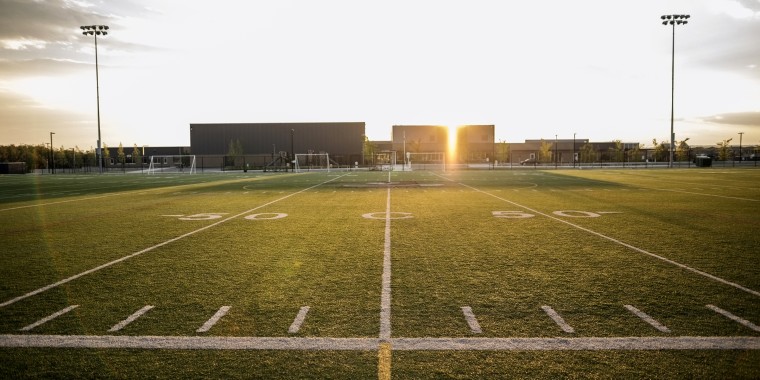When Justin Kelley was a freshman, he tried out for the Park View High School football team in Sterling, Virginia. He'd been playing football since he was 6, but was surprised to learn that at 14, he started as the varsity team’s center.
“No one was experienced enough to give him competition for that spot,” his mom Cyndi Kelley told TODAY. "He was able to hold his own, but he wasn’t very effective in his position as center with someone who was a lot bigger."
The team went 0 and 10 last year, but still Justin hoped to play this year. That is until Park View High School announced it was canceling its varsity football season.
“He was a little disappointed initially. After hearing the reasoning why, he very much understood,” Kelley explained. “He is very excited about the J.V. program and very excited to be part of the rebuild of the program.”
The reason for the scrapped varsity season? Only 18 students wanted to play and the Virginia High School League recommends that teams play with 25. Too few players makes it dangerous.
“When you consider safety, there was no other choice. It wouldn’t be fair of feasible. We want sports to be an enhancing experience and not a cause for injury,” Wayde Byard, spokesman for Loudoun County Public Schools, told TODAY.

But it’s not just Park View High that had to cancel its varsity football season. High schools across the country are sitting out this football season because of lack of participation. Since 2007, the National Federation of State High School Associations (NFHS) has observed waning interest in football.
While football remains the most popular among high school boys, the number of participants declined for the second year in a row, according to a report released Friday. In 2017, there was a 2 percent drop in football participants, slightly less than the 2.5 percent decrease in the 2015 to 2016 season. Since the 2009-2010 season, the numbers of students playing football decreased by 7 percent.
While stories of scrapped football seasons are becoming more common, the NFHS reports only a small number of schools, 20, scuttled their programs before the 2017 season — from 14,099 to 14,079.
“There are a variety of factors that contributed to that,” Bob Colgate, director of sports and sports medicine at NFHS, told TODAY. “Sometimes sports participation goes up. Sometimes it goes down.”
Lower interest in football
The reasons why fewer students are playing football aren’t entirely straightforward.
“The male students we have are not interested in playing football. I don’t think it is any big problem with the football program,” Steve Kilian, the athletic director at Wood Memorial High School in Oakland City, Indiana, which axed its varsity football season, told TODAY.
Only 13 boys showed up for football, but 17 boys tried out for soccer at Wood Memorial. Kilian and others believe the increased interest in soccer and lacrosse, both of which can be played year-round, is one of several reasons students are less interested in football.
“Kids are specializing in sports much earlier,” Jeff Nash, spokesman for the Chapel Hill-Carrboro City Schools in North Carolina, told TODAY. One district high school, Chapel Hill High School, canceled its season. “They don’t play three sports.”
At Chapel Hill High School, students play sports that have travel teams and clinics that allow them to play throughout the year. They think playing soccer or volleyball all year will make them better athletes and gives them an advantage for college athletics. Football season generally lasts from August to November with few off-season opportunities.
“Any other sport, whether you are on a school team or club team or private lessons, you are doing it year-round,” Nash said. “If you are on a basketball team and you are halfway decent and the other players are going to summer camps, you can’t stop and play football.”
Concussions and football.
Chronic traumatic encephalopathy (CTE) has emerged as a major concern for professional and college football players, but the school districts say that rarely comes up.
“I have not had any parents talk about concussions,” Kilian said.
Nash agreed: “It’s not a concussion thing.”
Colgate said concussion and injury garners loads of attention, but he thinks it's just one of a variety of reasons for decreased interest.
“The one thing I get asked all the time is, ‘Is it concussion?’ That is one element,” he said.
Kelley believes some parents worry unnecessarily about concussions. She said CTE was a problem 20 or 30 years ago because coaches and doctors didn’t understand how to prevent it. Now, she sees coaches protecting players by teaching them not to lead with their heads and making them go through rigorous concussion protocols.
“While that is unfortunate that CTE has happened, that has led coaches and doctors to research what happened to make the game safer today,” she said.
But Dr. Bennet Omalu, a forensic pathologist who discovered CTE, strongly recommends children under 18 skip contact sports, such as football, because it presents grave danger.
“We wouldn’t give a child a cigarette to smoke because a cigarette is potentially harmful. But we would put on a helmet of the head of a child and send him out on a field to play a game whereby he sustains repeated blows to his head, to suffer sub-concussion and concussion,” Omalu told TODAY in 2017. “We need to develop more brain-friendly, healthier type of sports.”
While the high schools that canceled football mourn the loss of their Friday night lights, they all plan on rebuilding.
"We enjoyed having football. The community wants to have football," Kilian said. "We have postponed the season and hopefully maybe we can get it going again."

